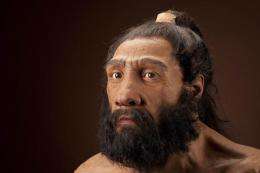June 17, 2011 report
Breeding with Neanderthals appears to have helped early humans fight disease

(PhysOrg.com) -- Following up on evidence that Homo Sapiens and Neanderthals mated and produced offspring, following the sequencing of the Neanderthal genome last year, Peter Parham, professor of microbiology and immunology at Stanford, set forth evidence in a presentation to the Royal Society in London last week that shows that humans benefitted from such encounters by having human leukocyte antigens (HLAs), added to their genomes, which in turn helped them to fight off diseases native to northern climates.
His findings show that as early humans began to move out of Africa, they mated with the race of incumbent Neanderthals producing offspring that were better suited to fighting off diseases that existed in the north, but not in Africa. Without this assistance it’s likely it would have taken Homo Sapiens much longer to adapt.
HLAs comprise a group of about 200 genes that are a vital part of our immune system. Some of these genes, known as alleles, are variable due to natural mutations in our chromosomes that occur as we continue to evolve in ways that hopefully help us fight off new diseases.
Parham found after studying HLAs in modern European and African people that early European humans developed alleles in their genes that were identical to the ones found in Neanderthals, which quite naturally leads to the conclusion that they got there via breeding. One allele in particular, HLA-C*0702, found in the Neanderthal, is quite common in modern European and Asian populations, but is absent in modern Africans.
And while the more recently discovered race of hominins in Siberia, called Denisovans, hasn’t had its genome sequenced yet, evidence thus far suggest that early humans mated with them as well, which also led to new alleles appearing in their genes; one such, the HLA-A*11 shows up in Asians, but not Africans.
To stress how important breeding with other hominins was to the success of early man, Parham notes that even though just 6% of the modern European genome comes from breeding with other early hominins, half of the existent HLA-A alleles owe their existence to such mixing of the races; and the percentage only goes up the farther native peoples were from Africa.
© 2010 PhysOrg.com




















